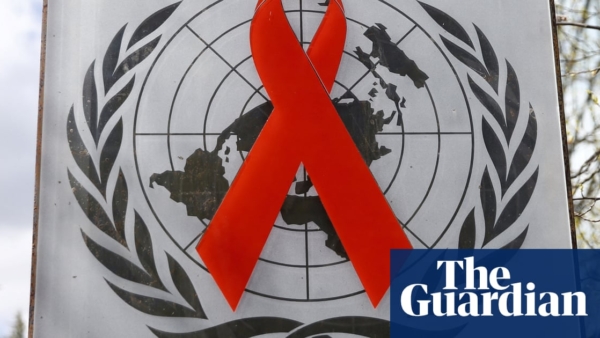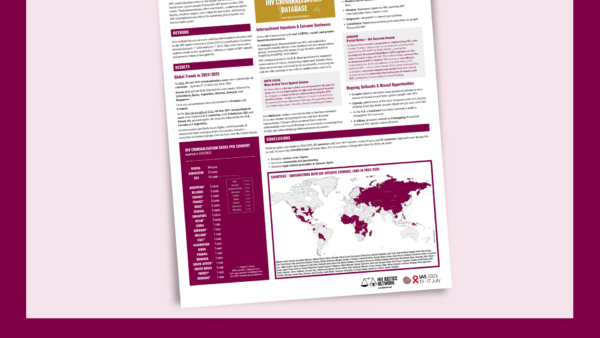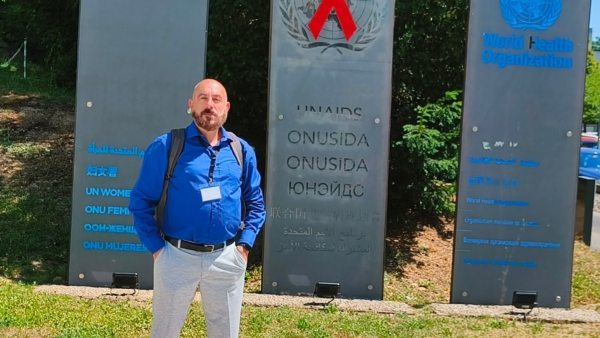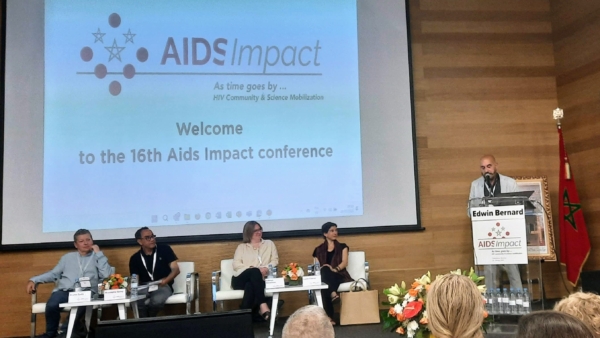The little brown church in Nashua, Iowa, has a certain notoriety. In the mid-1800s, a music teacher passing through the town wrote a song about a church that he envisioned there. It was a perfectly prophetic gesture.
A few years later, a church was erected on that very spot—even though its parishioners had never heard the teacher’s song. Ever since, the church has been a special place—and a popular destination for weddings. As of August 2014, over 74,000 had taken place there.
One of those was Tami Haught’s. On November 27th, 1993, just two days after Thanksgiving, she married Roger in a joyful ceremony. But unbeknownst to the guests, the newlyweds harbored a dark secret: Roger had AIDS, and Tami had HIV.
“The doctor said to cancel [the wedding] because [Roger] wouldn’t live,” Haught said.
Roger had been diagnosed with AIDS a few months before, on August 4th. Tami was diagnosed with HIV on August 23rd, the day before her 25th birthday.
Roger lived for almost three years after his diagnosis. He died about two months before the birth of their son Adrian.
In those three years, Roger and Tami chose to love each other. But in the outside world, they suffered a lot—especially from the stigma.
“Back in the 90s, if you had cancer, people cared. If you had AIDS, people judged,” Haught said.
Roger was diagnosed with HIV in 1984, but shortly thereafter, following a car accident, his bloodwork came back with a false negative for HIV. Wanting to believe that he didn’t really have HIV, Roger didn’t question those results, and never mentioned his previous HIV diagnosis to anyone—not even his fiancé.
“I didn’t have time to blame him,” Tami said. “I had slept with him without having the conversation. I had put myself at risk.”
“It was a heterosexual foolery that we didn’t have to worry about it, because we were straight, or didn’t do drugs,” Tami continued. “It was a rude awakening, and proof that HIV doesn’t discriminate.”
Like much of the American public during the late 80s and 90s, Roger’s own family struggled to understand HIV/AIDS and accept that he had it. What made Roger’s situation worse is that he himself never really accepted it, Haught added.
“He was a redneck, homophobic cowboy, and he absolutely hated living with AIDS,” Haught said.
Tami and Roger moved back to Roger’s native rural Texas briefly after their wedding because that’s where he wanted to live, but they didn’t find adequate support there, and Roger didn’t want to go to the doctor and risk being seen.
So they moved back to Iowa where he could be somewhat anonymous. He was treated two hours away from Haught’s hometown, at the University of Iowa Hospitals and Clinics in Iowa City, a university town. They told everyone except their families that he had cancer.
Three or four months before Roger died, he told Haught that he couldn’t keep fighting.
“Finally, it was emotionally as well as physically that he was tired. And passed away.”
The death certificate says he died of kidney failure.
“But what the death certificate doesn’t show are all the mental issues,” Haught said.
THE SEEDS OF STIGMA
Haught will always remember the day she disclosed her HIV status to her family: February 10th, 1993. A couple of months after her wedding.
“It’s a day that my sister will never forget,” Tami said. “I disclosed it in probably one of the absolute worst ways. I came home. I had gotten some flyers and brochures [on HIV/AIDS]. I threw them on the coffee table. [I said] ‘Roger has AIDS. I am living with HIV. I don’t know how long I will live. I’m tired, and I’m going to bed.’
“They sat there in shock,” Tami continued. “My brother stood up and gave me a hug and said: ‘No matter what you need, we love you. We’re here for you.’ Some people are disowned. I was very lucky that I’ve always had their support.”
That was especially true because they were living in a punitive social environment. Several states, including Iowa, had criminalization laws against people for not disclosing their HIV status to partners.
“In order to get Ryan White funding, states had to prove that if somebody was intentionally propagating HIV, they could be prosecuted,” Tami said. The Ryan White Care Act, also known as the AIDS Prevention Act of 1990, was designed to improve the care of people with HIV/AIDS, especially those without insurance.
To receive funding, states had to enact disclosure laws, which thirty-three states did.
“Iowa’s was the most punitive,” Tami said. “In Iowa, if you could not prove you had disclosed your status, you were sentenced to 25 years in jail and put on a sex offenders’ registry.”
But proof of disclosure was difficult, not least because the burden of proof was always on the person with HIV, Haught said. As a result, the law sometimes became a weapon against people with HIV.
“People stayed in abusive relationships,” Haught said. “[Partners would say things like], ‘If you break up with me, I will tell police that you did not disclose your status.’”
The laws were also enacted at a time when there was limited medical knowledge about the disease and how it is transmitted.
“In Texas, someone got thirty years for spitting at a corrections officer,” Haught recalled. “You cannot get HIV from spitting.”
Haught dealt with discrimination head-on in Iowa while she was raising her son. She first ran into it when she went to introduce herself at his preschool.
“The first time I went to meet [the teachers], they didn’t want to shake my hand,” she said.
Haught had a case manager who guided her through those early years of disclosing her HIV status in school environments. For example, she agreed not to make homemade treats at preschool—and to be fair, all the other parents agreed they also wouldn’t make treats.
“Luckily, Adrian didn’t have any issues until eighth grade,” Haught said. “A friend of his came over and made fun of Adrian. He said his mom had AIDS and was going to die.”
Haught called the boy’s father, who made him stop. But still, the seeds of that stigma—along with Haught’s fear of her own death—stayed with her.
“I never imagined that I would live long enough to see [Adrian] graduate in 2015,” Haught said. “I was a blubbering mess. On December 27th of this year, he made me a grandma.”
Haught said that she began living to live—instead of die—about twelve years ago. She was at the dentist, and the hygienist cleaning Haught’s teeth scolded her lightly for not flossing her teeth every day.
“She said, ‘In ten years, when you start losing your teeth, you will regret it,’” Haught said. “I knew the diagnosis was that we were living longer, healthier lives, but I just never believed it having lived through the loss of my husband.”
“But it was the trigger for me to think about what I was going to do if I didn’t die,” Haught said.
What she did was throw herself into activism.
THE EVOLUTION OF A CAUSE
Haught started an advocacy group in 2006 called PITCH, which stands for Positive Iowans Taking Charge. They now have about 125 members, with various support groups throughout the state and an annual wellness summit.
“Some people say they look forward to it every year,” Haught said. “It’s the only time they can be themselves and ultimately admit they have HIV. The rest of the year, they live in silence.”
Haught also became involved with a national group called SERO, which is focused on ending inappropriate criminal persecutions of people with HIV. They are helping to repeal, state by state, criminalization laws that are rooted in a poor understanding of HIV transmission. Most laws do not consider that correct and consistent condom use as well as the use of antiretroviral therapy reduces the risk of transmission to a negligible level.
The National HIV/AIDS Strategy, released by the White House in 2010, also called attention to the problem of HIV criminalization, and the CDC has encouraged states to revisit these laws. The American Psychological Association has spoken out against HIV criminalization, recommending the repeal or reform of these laws so that they only punish HIV positive people who intentionally engage in behavior that is risky for transmission.
On its website, SERO lists several recommended actions for HIV positive people to protect themselves, including having sexual partners sign disclosure forms and saving all written communication should it be questioned.
So far, two states have reformed their laws: Iowa and Colorado. In 2014, Iowa replaced the 25-year flat prison sentence with a tiered sentencing system, depending on the circumstances of HIV transmission.
“I was actually speechless,” said Haught, who between 2012 and 2014 served as community organizer for CHAIN (Community HIV/Hepatitis Advocates of Iowa Network). Five days later, 200 activists came to Iowa to celebrate—and to ceremoniously cut off the ankle monitors on two HIV positive Iowans who had been forced to wear them under the old law.
Last May, Colorado became the second state to reform its laws.
“We’re working in other states to make progress,” Haught said, who as SERO’s organizing and training coordinator travels around to different states lobbying legislators.
“It’s really tough in the South,” she added.
THE LAW THAT ALMOST TOOK DOWN AN OLYMPIAN
In March, Haught was lobbying in Florida, the state with the highest number of HIV diagnoses. It is fourth in the nation for people living with HIV/AIDS.
Darren Chiacchia, an equestrian who won the Bronze medal in the 2004 Olympics, is one of those people. Chiacchia, who lives for part of the year on a horse farm in North Central Florida (and the other part in upstate New York) also knows first-hand the challenges of Florida’s HIV criminalization law and the stigma surrounding it.
In 2009, Chiacchia’s former lover Chandler decided to take revenge on Chiacchia for ending their four-month relationship: Chandler filed a report to the Marion County Sheriff’s Department claiming that he had found out about Chiacchia’s HIV status only one month before. Had that been true, Chiacchia would have violated Florida law by having had sex more than once without revealing his HIV status to his partner.
Chiacchia says he told Chandler about his status on their first date. “His [Chandler’s] reaction was, ‘True love will prevail,’” Chiacchia said.
But the relationship was rocky from the start, and every time Chiacchia tried to end it, Chandler threatened him with: ‘Don’t do this. Your life will be over as you know it.’
The twist in the story is that there were times that Chiacchia questioned his own truth. “He [Chandler] almost had me convinced that I hadn’t told him,” Chiacchia said.
A near-fatal horse accident in 2008 had left Chiacchia with Traumatic Brain Injury, which often comes with deep memory lapses. Incidentally, it was while hospitalized for the accident that Chiacchia found out he had HIV.
“It didn’t really freak me out,” he said. “It was just something that had to be taken care of.”
While recovering from the accident, Chiacchia fell into his relationship with Chandler. He was vulnerable, and his brain, he said, was “very malleable.”
It was only when Chiacchia, who’d made millions as a professional athlete, was sliding into bankruptcy to defend his case, that he began to recover his memory. To make sure his tax returns were up to date, he did his own forensic accounting, collecting the restaurant and country club receipts. That unlocked his memory about the night he told Chandler that he had HIV.
He reconstructed that night, and went back to the restaurant where he’d taken Chandler.
“I sat at the same stool at the end of the bar. I ordered my same favorite cocktail. I ordered my same favorite meal, and then afterwards I pulled into the same vacant parking lot where it all happened,” he said.
At that point, the case might have just ended up being a case of conflicting reports, but Chiacchia had a few other factors in his favor:
“Florida statute reads that the person must be informed,” Chiacchia said. “So what about the three other people who told him [my HIV status] instead?”
They all testified in favor of Chiacchia.
Also, to sue someone for HIV-related crimes, Chiacchia explained, HIV transmission must take place. “He [Chandler] gleefully reported himself negative,” Chiacchia said.
In February, after eight years of legal battles and debt, the Florida assistant state attorney dropped all charges against Chiacchia. It was the start of the biggest horse show of the year in Marion County, known as the horse capital of the world. It is Florida’s fifth largest county, as well as one of its most rural.
Chandler had suffered stigma living there during the eight years of his legal battles. He was in earshot of comments like, ‘They’re a couple of queers. They belong in jail anyway,’ Chiacchia said. His livelihood training equestrians and buying and selling prize horses suffered.
“People were quick to judge. My life as I knew it was over,” Chiacchia said. “That’s the stigma we’re talking about.”
That all changed when his case was cleared.
“The week the news hit was the first day of the horse show, and I think I got twenty-five hugs from people,” he said. “That was amazing.”
Chiacchia still has his horse farm in the thicket of Florida’s horse country. He’s grooming ten future champion horses and training young equestrians from all over the world, who in exchange help him out on the farm where he keeps an array of sheep, donkeys, chickens and dogs.
He’s always been a hustler, he said. Starting from the moment, when as a twelve-year-old delivering newspapers, he was first mesmerized by horses at the race track in Buffalo, New York, where he grew up. Since then, he’s tenaciously pursued his dreams—even in the face of the accusations.
His main concern with the HIV criminalization laws is that they empower accusations, he said.
“They also give people a false sense of security that someone wouldn’t do that,” meaning not reveal their HIV status. “Imagine a father telling his daughter not to worry whether she’s pregnant because it’s a guy’s responsibility.”
“The law suggests one’s sexuality is someone else’s responsibility,” he said. “People who don’t know their own status are the worst risk group.”
According to the CDC, 13 percent of HIV positive people in the U.S. over age 13 don’t know their status. Chiacchia said he wants to get more involved with education efforts now that the burden of his trial is over.
He’s acutely aware that most people with HIV similarly accused might not have had the resources to fight such a battle. HIV, especially in rural areas, disproportionately affects the poor.
“I’m an upper-middle class, white male, an Olympic athlete, living the American Dream, and this law almost took me down,” he said. “Think about all the other people out there.”
THE DEEP SOUTH: THE PERFECT STORM FOR HIV
AIDS activist Kathie Hiers remembers when the scope of the HIV/AIDS crisis in her home state of Alabama hit her. She was doing a home visit in Choctaw County, a deeply rural county with just under 14,000 inhabitants. Hiers was visiting a mother and her two daughters—all of whom were HIV positive. The older daughter was pregnant, and the younger one had pneumonia. The younger one sat facing the open oven door. She had a towel over her head to capture the heat, since they couldn’t afford to heat their home. A few weeks later, she died.
“Unfortunately, we just didn’t get her into care in time,” Hiers said, adding that all three women, who developed full-blown AIDS, had not been in regular care.
“They were sharing their medications with their boyfriends, thinking that would keep them from getting it. They weren’t getting the proper dosages,” Hiers added.
Poverty, lack of access to health care, pervasive stigma, racial inequalities and a high rate of STIs (sexually-transmitted infections)—which make it easier to transmit HIV—have made the rural South “the perfect storm for HIV,” Hiers said.
“Alabama is 50 percent plus rural, and it is exceedingly difficult to serve these people adequately,” Hiers added.
According to a recent report by the Center for Health Policy and Inequalities Research at Duke University, the South has had the highest number of HIV diagnoses for over a decade.
Of the 17 states comprising the South, the nine that make up the Deep South are particularly afflicted. In 2013, 40 percent of the country’s HIV diagnoses occurred in the Deep South, which accounts for only 28 percent of the U.S. population. The states in this region include Florida, Georgia, Louisiana, Mississippi, North Carolina, South Carolina, Tennessee and Texas.
African-Americans in the South are also disproportionately affected by HIV. In 2013, 53 percent of the diagnoses in the Deep South were in African-Americans, compared to 44 percent in the U.S.
The Deep South has also traditionally had the highest death rates for people with HIV. Between 2008 and 2013, 43 percent of deaths in the U.S. attributed to HIV were in the Deep South, according to the report.
“You should not be dying from HIV in this day and age,” said Carolyn McAllaster, the Director of the Duke HIV/AIDS Policy Clinic. “If you’re on treatment, it’s a chronic illness with normal life expectancies. The folks who are dying are dying from inadequate care—late diagnosis, or not accessing care once they’ve been diagnosed.”
“The higher death rates are telling the story better than any number that we have,” she added.
Also, people with HIV in the rural Southeast were more likely to have an AIDS diagnosis within a year of being diagnosed with HIV, according to the report.
One of the problems is that rural areas in the South lack physicians. According to the report, 40 percent of HIV-specific providers are in the South, where 44 percent of the country’s HIV positive people are. Transportation issues also disproportionately affect people in rural areas. Some patients don’t have cars and can’t get to clinics—and they don’t want to ask for help lest people find out about their status.
“If they don’t have a car, stigma can kick in,” McAllaster said.
Stigma persists amongst providers as well, McAllaster added.
“Primary care providers do not want to prescribe PrEP because they think it will encourage risky sex,” she said. PrEP, or pre-exposure prophylaxis, is a preventive medication for people who are at substantial risk of HIV.
McAllaster likens likens the resistance to PrEP to the resistance to birth control pills because “they think she’ll sleep around.”
For similar reasons, sex education is not taught in schools in much of the South, which ultimately leads to unsafe practices, Hiers said. In Alabama, the number of young people with HIV has increased from one in four to one in three.
To overcome some of these hurdles, Hiers, the CEO of the nonprofit AIDS Alabama, has been working to get help and resources for HIV positive people in all of the state’s 67 counties. She started a telemedicine initiative so that people can be seen remotely—and privately.
“We’re learning that people would rather [our offices] not be located at health departments. A lot of peoples’ relatives work at the health department, and people are afraid of losing confidentiality,” Hiers said.
Local initiatives like this also help offset a disparity in funding at the national level for the rural South.
“A lot of the resources go to the big, urban areas,” McAllaster said. “A lot of our advocacy is around getting resources to the rural areas and smaller cities.”
Hiers added that certain urban areas like New York and San Francisco have almost ended the epidemic. “I tell my colleagues in bi-coastal areas that they will never end the epidemic in the U.S. without dealing with the South,” she said.
The updated National HIV/AIDS Strategy (NHAS) targets the South, with the goal of reducing HIV diagnoses by 25 percent within five years.
THE FUTURE OF HEALTH COVERAGE
Hiers breathed a sigh of relief when Trumpcare failed to pass in late March.
“Nothing about it was good for people with HIV,” she said, adding that the Affordable Care Act gave many HIV positive people a window of opportunity to access affordable healthcare and medications.
“Definitely the ACA helped people with HIV, even if they weren’t in states that expanded Medicaid,” she added. As an example, in Alabama—a non-expansion state—five percent of people with HIV signed up for the exchanges, she said.
In expansion states, Medicaid coverage for people with HIV increased six percent between 2012 and 2014 nationwide. In those same states, the uninsured rate of people with HIV dropped six percent, according to the Kaiser Family Foundation.
Haught said that the ACA also gave her access to more physicians.
“For the first time in twenty years, I was able to go to doctor five minutes from home, and I get all my medications from one source,” Haught said, adding that before the ACA, she would drive five hours round-trip just to see one doctor.
She is worried that any changes to the ACA will negatively affect people living with HIV.
“[Losing coverage] impacts adherence. If affects our lives. If we don’t get our medications, we will die.”
“I’ve seen that death,” she continued. “I wouldn’t wish it on anyone.”
While no one can predict the changes coming around the corner, one thing is certain for HIV activists:
“It’s not the right time to pull back in resources,” McAllaster said. “We’ve made some real advances in fighting this epidemic.”
Just a few days after the AHCA was sent back to the drawing board, activists were celebrating some of those advances—and advocating for more—at AIDS Watch. On March 28th over 650 people from 34 states gathered in Washington D.C. to educate members of Congress about their needs.
“I went to something that really choked me up,” Hiers said. “It’s a new wave of what’s coming.”
The presentation was called “Undetectable Equals: untransmittable,” and featured discussion of three major studies that have shown that HIV-positive people who are virally suppressed cannot transmit HIV. That knowledge should help revamp states’ criminalization laws, she said.
But the more profound impact might be an internal one to people living with HIV, she added.
“It was so moving to see HIV positive people change their perception of themselves. They don’t have to think of having sex as a loaded gun anymore. It’s really an encouragement for people to stay on theirs meds.”
Published in Rural Health Quarterly on May 12, 2017








